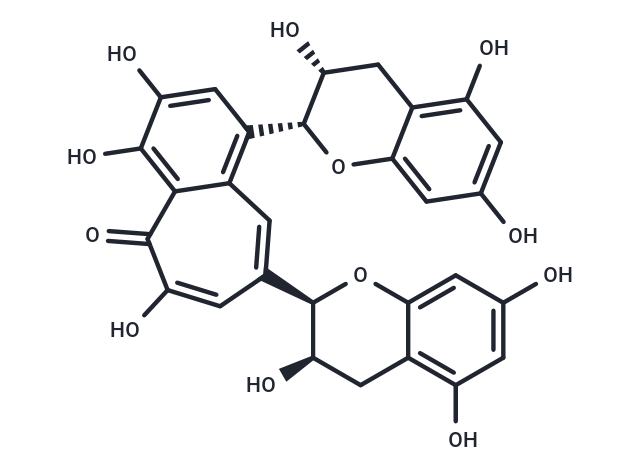Shopping Cart
- Remove All
 Your shopping cart is currently empty
Your shopping cart is currently empty

Theaflavin is a polyphenolic flavonoid that has been found in black tea and has diverse biological activities, including antioxidant, anticancer, anti-inflammatory, and antiviral properties

| Pack Size | Price | Availability | Quantity |
|---|---|---|---|
| 1 mg | $45 | In Stock | |
| 5 mg | $98 | In Stock | |
| 10 mg | $155 | In Stock | |
| 25 mg | $238 | In Stock | |
| 50 mg | $352 | In Stock | |
| 100 mg | $523 | In Stock | |
| 200 mg | $756 | In Stock |
| Description | Theaflavin is a polyphenolic flavonoid that has been found in black tea and has diverse biological activities, including antioxidant, anticancer, anti-inflammatory, and antiviral properties |
| In vitro | Theaflavin inhibits the growth of OVCAR-3 and A2780/CP70 human ovarian cancer cell lines, but not the ovarian epithelial cell line IOSE 364 (IC50s = 11.9, 38.5, and >40 μM, respectively)[1]. |
| In vivo | In the pretreated ICH rats Theaflavin significantly alleviated the behavioral defects, protected BBB integrity, and decreased the formation of cerebral edema and the levels of ROS as well as inflammatory cytokines (including interleukin-1 beta [IL-1β], IL-18, tumor nectosis factor-alpha, interferon-γ, transforming growth factor beta, and (C-X-C motif) ligand 1 [CXCL1]).Nissl staining and TUNEL displayed Theaflavin could protect against the neuron loss and apoptosis via inhibiting the activation of nuclear transcription factor kappa-β-p65 (NF-κβ-p65), caspase-1, and IL-1β[2]. |
| Cell Research | Cell proliferation assay, Hoechst 33342 staining assay, Caspase-Glo Assay, western blot, human umbilical vein endothelial cell tube formation assay and vascular endothelial growth factor (VEGF) enzyme-linked immunosorbent assay were performed[1]. |
| Animal Research | ICH rat models were induced with type VII collagenase and pretreated with TF by gavage in different doses (25 mg/kg-100 mg/kg).?Twenty-four hours after ICH attack, evaluated the rats' behavioral performance, the blood-brain barrier (BBB) integrity, and the formation of cerebral edema.?The levels of reactive oxygen species (ROS) and inflammatory cytokines were examined by 2',7'-dichlorofluorescin diacetate and enzyme-linked immunosorbent assay.?Nissl staining and transferase dUTP nick end labeling (TUNEL) were aimed to detect the neuron loss and apoptosis, the mechanism of which was explored by Western blot[2]. |
| Molecular Weight | 564.49 |
| Formula | C29H24O12 |
| Cas No. | 4670-05-7 |
| Smiles | O[C@@H]1Cc2c(O)cc(O)cc2O[C@@H]1c1cc(O)c(O)c2c1cc(cc(O)c2=O)[C@H]1Oc2cc(O)cc(O)c2C[C@H]1O |
| Relative Density. | 1.777 g/cm3 (Predicted) |
| Storage | store at low temperature,keep away from direct sunlight,keep away from moisture | Powder: -20°C for 3 years | In solvent: -80°C for 1 year | Shipping with blue ice. | ||||||||||||||||||||
| Solubility Information | DMSO: 5.65 mg/mL (10 mM), Sonication is recommended. | ||||||||||||||||||||
Solution Preparation Table | |||||||||||||||||||||
DMSO
| |||||||||||||||||||||

Copyright © 2015-2025 TargetMol Chemicals Inc. All Rights Reserved.